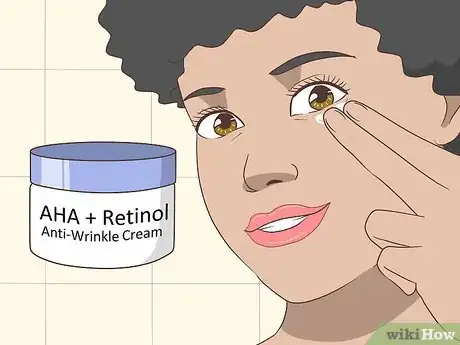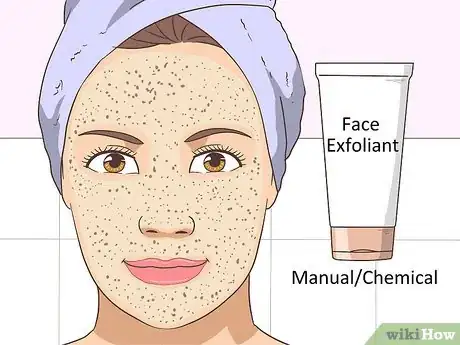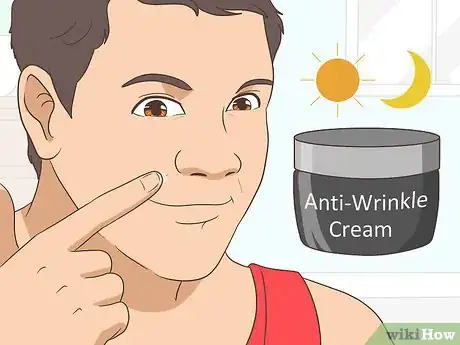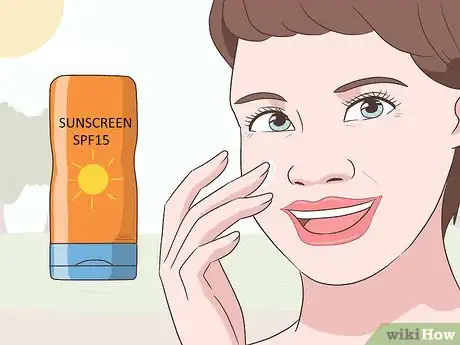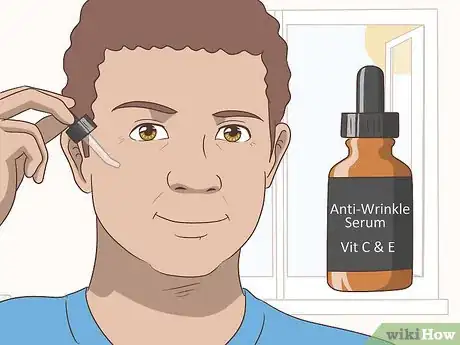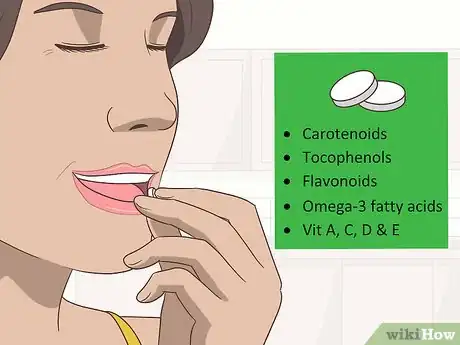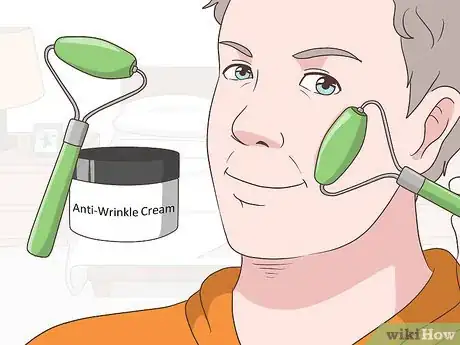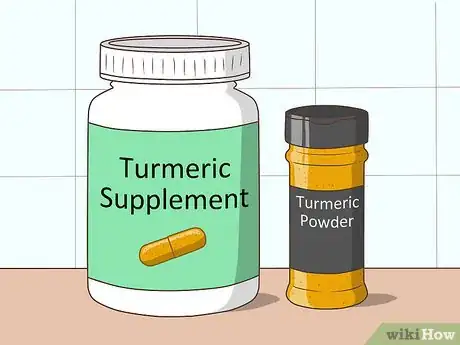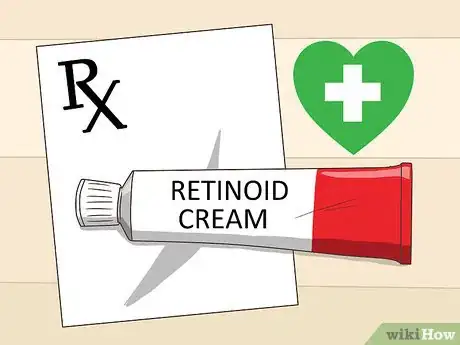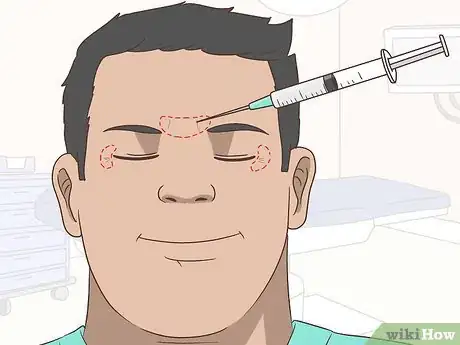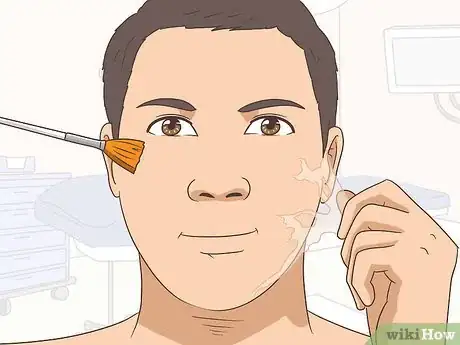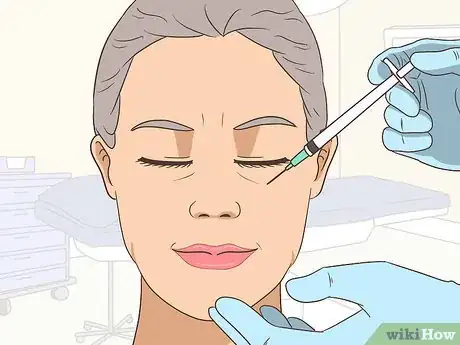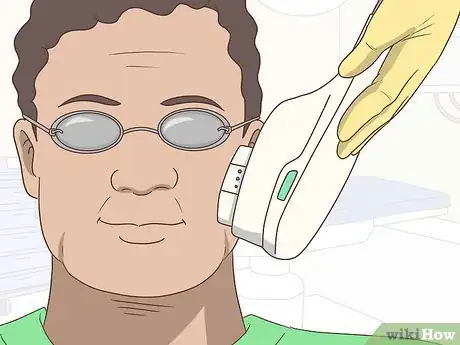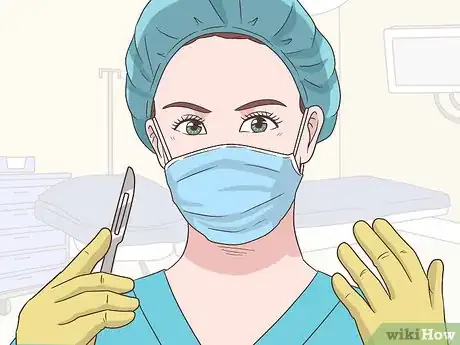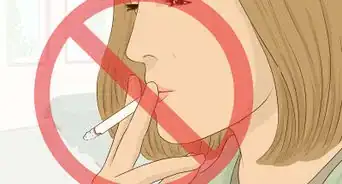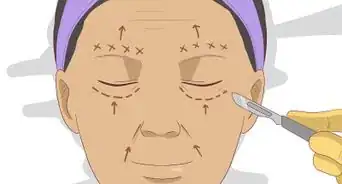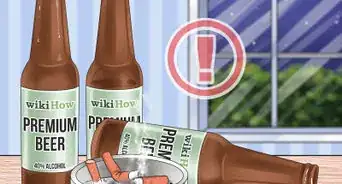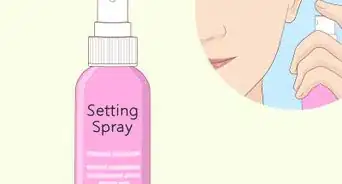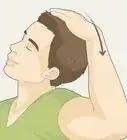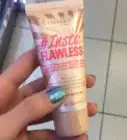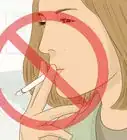This article was medically reviewed by Daniel Barrett, MD. Dr. Daniel Barrett is a Board Certified Plastic Surgeon and the owner of Barrett Plastic Surgery based in Beverly Hills, California. With over six years of plastic surgery experience, Dr. Barrett specializes in aesthetic and reconstructive surgery of the face, nose and body. He has developed detailed scar management protocols and closure techniques to reduce the appearance of scars for his patients. Dr. Barrett obtained a BS from James Madison University and an MD along with an MS in Physiology and and an MHA (Masters of Health Administration) from the Medical College of Virginia in Richmond.
There are 25 references cited in this article, which can be found at the bottom of the page.
wikiHow marks an article as reader-approved once it receives enough positive feedback. In this case, 80% of readers who voted found the article helpful, earning it our reader-approved status.
This article has been viewed 363,335 times.
Wrinkles are a normal part of aging, but they can affect your self-confidence. If you have wrinkles and want to do something to get rid of them, start by trying some skin care products available without a prescription, as well as home remedies that can boost your anti-wrinkle regimen. If you don't get the results you are hoping for, then see a dermatologist or cosmetic surgeon for treatments that can help you to look and feel your best.
Steps
Using Non-Prescription Skin Products
-
1Look for an anti-wrinkle cream containing retinol or vitamin C. Choose an over-the-counter cream containing a beneficial active ingredient, such as retinol or vitamin C.[1] Products that are more expensive or that contain more active ingredients may not be more effective than products that contain only 1 or 2 active ingredients, so don't let these factors sway you to choose 1 anti-wrinkle cream over another. Try your cream for 6-8 weeks before evaluating its effectiveness. Some other helpful active ingredients to look for include:[2]
- Alpha-hydroxy acids (AHAs)
- Coenzyme Q10
- Peptides
- Tea extracts
- Grape seed extract
- Niacinamide
-
2Cleanse your skin daily with a gentle cleanser. Keeping your skin clean and avoiding irritation while cleansing your skin is another great way to minimize the appearance of wrinkles.[3] Choose a facial cleanser that is labeled as gentle or for sensitive skin, and wash your face with it in the morning, at night, and any time your skin is sweaty or dirty.[4]
- Choose a cleanser that does not contain any exfoliants. These are more likely to irritate your skin.
Advertisement -
3Exfoliate your skin twice a week with a manual or chemical exfoliant. A manual exfoliant contains granules that polish your skin, while a chemical exfoliant dissolves the dead skin cells. This will buff away dead skin cells to reveal younger, smoother skin. The best time to exfoliate is in the morning, as your skin repairs itself overnight.
- If you choose to use a chemical exfoliant, you can do a mini chemical peel at home. You can obtain a kit at most beauty stores.
- If you choose to use an exfoliating brush, you can use it daily.[5]
- You could also make your own exfoliant using ingredients like salt, sugar, baking soda, coffee grounds, honey, or lemon juice.
-
4Use an anti-wrinkle cream twice daily. No product will produce dramatic results overnight. It will take at least a few weeks of regular use and possibly a couple of months before you notice a difference. You will likely need to apply the anti-wrinkle cream in the morning and at night after cleansing your skin. Follow the instructions on the package for use and see if your wrinkles improve after a month or 2.[6]
- Keep in mind that products that contain alpha-hydroxy acids or retinol may irritate the skin around your eyes. You may want to avoid applying these creams to the eye area or only use a small amount in these areas.
- The anti-wrinkle cream may be heavy enough to take the place of a moisturizer. If not, apply a rich, non-comedogenic, hypoallergenic moisturizer to your skin after cleansing.[7] Use gentle circular motions to work the moisturizer into your skin, focusing on your wrinkles.
-
5Apply sunscreen. Exposure to the sun can accelerate aging and increase the appearance of wrinkles.[8] Apply an SPF 15 or higher sunscreen to your skin any time you will be outside for more than 15 minutes. You can apply sunscreen over your moisturizer or look for a moisturizer that includes sunscreen.
- Reapply your sunscreen every 2 hours during sun exposure or any time you get wet or after sweating excessively.
- Sun exposure can accelerate the signs of aging and increase your risk of skin cancer no matter what color skin you have.[9]
- It's best to use a sunscreen that is made of natural ingredients and contains zinc or titanium oxide, which provide sun protection.
-
6Look into anti-wrinkle serums. There are tons of anti-wrinkle serums on the market that claim to reduce the appearance of wrinkles, and some of them may work for you. Keep in mind that the results you get from any over-the-counter treatments will be modest, but over time you may see a noticeable reduction in wrinkles. Look for serums that contain antioxidants, such as Vitamins C, B3, and E.[10]
- Remember that paying high prices for anti-wrinkle products of any kind does not guarantee that they will work. These products are not regulated by the FDA.
-
7Take skin-boosting supplements that contain antioxidants. Vitamins and minerals help support your skin's health and appearance. Carotenoids, tocopherols, flavonoids, omega-3 fatty acids, and vitamins A, C, D, and E are all great options. Additionally, protein and lactobacilli can also support healthy skin. You can get these nutrients through your diet or supplements.[11]
- Talk to your doctor before taking supplements.
Using Home Remedies
-
1Try massaging your face. Massaging your skin using a device or your fingertips may help to reduce wrinkles.[12] This works best when you combine the skin massage with an anti-wrinkle regimen, such as cleansing and using an anti-wrinkle cream. Purchase a facial massager and use it after applying your anti-wrinkle cream, or use your fingers to massage your skin when you apply the cream.
- Keep in mind that it will take 4 to 8 weeks to see results, and the results will be subtle.
-
2Include turmeric in your diet. Topical application of turmeric has not been shown to produce any effect on wrinkles, but ingesting more of this spice may help to reduce the formation of wrinkles. Try adding 1 to 2 teaspoons of turmeric to your recipes. You can also take a supplement. Look for turmeric capsules and follow the manufacturer's recommendations for supplementing.[13]
- Make sure to talk to your doctor before taking any new supplement, especially if you are taking a prescription medication.
-
3Apply rooibos tea to your skin. One study looked at the efficacy of anti-wrinkle creams that contained herbal agents, and the formulation that contained rooibos was the most effective at reducing wrinkles.[14] You can look for an anti-wrinkle-cream that contains rooibos or brew some tea and apply the cooled tea to your skin using cotton balls.
- Brew a cup of tea using 1 teaspoon or 1 teabag of rooibos to 8 imperial fluid ounces (230 mL) of hot water.
- Steep the tea for 5 minutes, and remove the tea infuser or bag.
- Let the tea cool to room temperature and then use cotton balls to apply the tea to your freshly washed skin.
- Leave the tea on your skin and apply moisturizer over it.
Seeking Medical Treatment for Wrinkles
-
1Ask your doctor about prescription retinoid creams. The first line of treatment for wrinkles may be a topical cream that you apply to your skin daily. These creams can reduce the appearance of wrinkles and improve the overall appearance of your skin.[15]
- Retinoid creams may leave your skin feeling itchy, irritated, and dry. You may also experience a burning or tingling sensation after applying the cream. Tell your doctor if these side effects bother you.
- Protect your skin from the sun while using retinoid creams, such as by applying an SPF 15 or higher sunscreen and wearing a wide-brimmed hat and sunglasses.
- The cream will probably not be covered by your insurance, so it may cost around $100 for each tube of the product.
-
2Ask about botox. Botox injections are a popular treatment option for wrinkles that are caused by movement, like crow's feet and frown lines.[16] You may see a dramatic reduction in your wrinkles about 2 weeks after treatment. As with any medical treatment, there are some risks, including infection, allergic reaction, and pain.[17]
- If you aren't sure about botox, try getting a small area treated. For example, you might get a small dose between your eyebrows, near your crows feet, or around your lips to see if you like the results.
- Keep in mind that the results will last for 3 to 4 months and then you will need to have another treatment to get rid of the wrinkles again.
-
3Look into laser resurfacing. Laser treatments can help to improve the overall appearance of your skin while also targeting fine lines and wrinkles. There are two types of lasers used to treat wrinkles: ablative and non-ablative. Ablative lasers remove the top layer of skin to reveal new skin beneath it. Non-ablative lasers only heat the skin without removing the top layer, and this encourages new skin growth.[18] Your doctor can talk to you about your options and help you decide which one is best for your situation.[19]
- Laser treatment may be painful depending on the intensity of the laser. Anesthesia may or may not be required depending on the area being treated and the depth of the treatment.
- Non-ablative laser treatments cost an average of $1,031 and ablative laser treatments cost an average of $2,330.[20]
-
4Get a chemical peel. Chemical peels use a special solution that is applied to the skin on your face and left on for a specific amount of time. Over the next few days, your skin will peel away to reveal the skin below it. This will reduce the appearance of wrinkles and fine lines on your skin.[21]
- Chemical peels come in different levels, such as light, medium, and deep. A light peel will yield less dramatic results than a deep peel, but you may only need a light peel if you have some fine lines that you want to get rid of. For wrinkles, a medium to deep peel may work best.
- Depending on the depth of the peel, anesthesia may be required and you may have to have the procedure done by a cosmetic surgeon. A light peel may be done by an aesthetician or nurse with special training.
- The average cost of a chemical peel is $638.[22]
-
5Consider microdermabrasion. Microdermabrasion is a deep exfoliating treatment that removes dead and damaged skin from the top layer to reveal healthier skin underneath it. This procedure is non-invasive and low-risk. Some people even combine the treatment with a chemical peel to get more dramatic results.[23]
- This treatment works well for fine lines and wrinkles like crow's feet.
- You will need to avoid exposure to the sun after your treatment.
- The average cost of 1 microdermabrasion treatment is $138.[24]
-
6Ask a cosmetic surgeon about dermabrasion. Dermabrasion is a more aggressive form of exfoliating the skin where a cosmetic surgeon uses a powerful sander or blade to remove a layer of skin from the desired area, such as an area with a lot of wrinkles. This treatment requires sedation and there is a risk of infection following the procedure.[25]
- This treatment works well for smile lines and vertical lip lines.
- Your skin will be sore and tender after the treatment, so it is important to follow your doctor's instructions for care. You will also need to stay out of the sun until your skin heals.
- The average cost of 1 dermabrasion treatment is $1,162.[26]
-
7Consider soft tissue fillers. Filling the skin with an implant can also diminish the appearance of wrinkles. Soft tissue fillers, also known as wrinkle fillers and injectable implants, work well for reducing the appearance of wrinkles in the face, especially in the mouth and cheek areas.[27] Soft tissue fillers may also be used to reduce the appearance of wrinkles in the back of your hands.
- Ask your dermatologist about the possibility of using soft tissue fillers to correct your wrinkles.
- Keep in mind that soft tissue fillers come with a risk of swelling and pain that may last for weeks, months, or even years in some rare cases. You will also be at risk of infection and allergic reaction when you receive these injections, so tell your doctor if you notice any unusual pain, swelling, redness, drainage, or bruising.
- Dermal fillers cost anywhere from $600 to $2,000 depending on the type of filler and the area that is treated.[28]
-
8
-
9Consider facelift surgery. If none of the non-surgical options you have tried produce the results you want, then you may want to consider having a surgical facelift. Facelift surgery will produce dramatic results that last from 5 to 10 years.[33]
- Keep in mind that surgery is expensive. Expect to pay anywhere from $3,500 to $20,000 depending on the doctor and procedure.
- There are risks with a facelift as with any surgery. Discuss the risks with your cosmetic surgeon to help you decide if the risks are worth the potential benefits.
Expert Q&A
Did you know you can get expert answers for this article?
Unlock expert answers by supporting wikiHow
-
QuestionDo fillers make you look younger?
 Paul Friedman, MDPaul Friedman, MD, is a Board-Certified Dermatologist, and the Director and Founder of the Dermatology & Laser Surgery Center in Houston, Texas. He has over 25 years of experience and specializes in Mohs micrographic surgery, dermatologic laser surgery, and cosmetic dermatology. Dr. Friedman is the current President of the American Society for Laser Medicine & Surgery and was named by Newsweek Magazine as one of the Best Dermatologists in America for Laser Treatments. His awards include the Husk Prize for his research in dermatologic surgery and the Young Investigator's Writing Competition Award of the American Society for Dermatologic Surgery. Dr. Friedman completed his dermatology residency at the New York University School of Medicine and received his medical degree with the highest honors from the University of Tennessee Health Science Center, College of Medicine.
Paul Friedman, MDPaul Friedman, MD, is a Board-Certified Dermatologist, and the Director and Founder of the Dermatology & Laser Surgery Center in Houston, Texas. He has over 25 years of experience and specializes in Mohs micrographic surgery, dermatologic laser surgery, and cosmetic dermatology. Dr. Friedman is the current President of the American Society for Laser Medicine & Surgery and was named by Newsweek Magazine as one of the Best Dermatologists in America for Laser Treatments. His awards include the Husk Prize for his research in dermatologic surgery and the Young Investigator's Writing Competition Award of the American Society for Dermatologic Surgery. Dr. Friedman completed his dermatology residency at the New York University School of Medicine and received his medical degree with the highest honors from the University of Tennessee Health Science Center, College of Medicine.
Board Certified Dermatologist, American Board of Dermatology As we age, we lose a little bit of collagen, fat, muscle, and even bone in our face. This can result in wrinkles, as it causes a loss of structural support in your face. Fillers can restore that volume loss, which helps improve the appearance of some of the lines that result from the loss of structural support.
As we age, we lose a little bit of collagen, fat, muscle, and even bone in our face. This can result in wrinkles, as it causes a loss of structural support in your face. Fillers can restore that volume loss, which helps improve the appearance of some of the lines that result from the loss of structural support. -
QuestionIs it possible to get rid of wrinkles?
 Paul Friedman, MDPaul Friedman, MD, is a Board-Certified Dermatologist, and the Director and Founder of the Dermatology & Laser Surgery Center in Houston, Texas. He has over 25 years of experience and specializes in Mohs micrographic surgery, dermatologic laser surgery, and cosmetic dermatology. Dr. Friedman is the current President of the American Society for Laser Medicine & Surgery and was named by Newsweek Magazine as one of the Best Dermatologists in America for Laser Treatments. His awards include the Husk Prize for his research in dermatologic surgery and the Young Investigator's Writing Competition Award of the American Society for Dermatologic Surgery. Dr. Friedman completed his dermatology residency at the New York University School of Medicine and received his medical degree with the highest honors from the University of Tennessee Health Science Center, College of Medicine.
Paul Friedman, MDPaul Friedman, MD, is a Board-Certified Dermatologist, and the Director and Founder of the Dermatology & Laser Surgery Center in Houston, Texas. He has over 25 years of experience and specializes in Mohs micrographic surgery, dermatologic laser surgery, and cosmetic dermatology. Dr. Friedman is the current President of the American Society for Laser Medicine & Surgery and was named by Newsweek Magazine as one of the Best Dermatologists in America for Laser Treatments. His awards include the Husk Prize for his research in dermatologic surgery and the Young Investigator's Writing Competition Award of the American Society for Dermatologic Surgery. Dr. Friedman completed his dermatology residency at the New York University School of Medicine and received his medical degree with the highest honors from the University of Tennessee Health Science Center, College of Medicine.
Board Certified Dermatologist, American Board of Dermatology My recommendations vary based on the degree of sun damage and my patients' willingness to go under the knife. For somebody with advanced sun damage and a desire for a non-invasive procedure, I would recommend using resurfacing devices. These can help tighten the skin and give you some improvement in more advanced types of wrinkles. There are also other energy-based devices that dermatologists commonly use, such as radio frequency or ultrasound devices, that can result in some skin tightening as well. Various types of injectables, such as fillers, can also help relax muscles temporarily to soften the appearance of lines and help restore volume loss in your face.
My recommendations vary based on the degree of sun damage and my patients' willingness to go under the knife. For somebody with advanced sun damage and a desire for a non-invasive procedure, I would recommend using resurfacing devices. These can help tighten the skin and give you some improvement in more advanced types of wrinkles. There are also other energy-based devices that dermatologists commonly use, such as radio frequency or ultrasound devices, that can result in some skin tightening as well. Various types of injectables, such as fillers, can also help relax muscles temporarily to soften the appearance of lines and help restore volume loss in your face. -
QuestionHow do fillers work?
 Daniel Barrett, MDDr. Daniel Barrett is a Board Certified Plastic Surgeon and the owner of Barrett Plastic Surgery based in Beverly Hills, California. With over six years of plastic surgery experience, Dr. Barrett specializes in aesthetic and reconstructive surgery of the face, nose and body. He has developed detailed scar management protocols and closure techniques to reduce the appearance of scars for his patients. Dr. Barrett obtained a BS from James Madison University and an MD along with an MS in Physiology and and an MHA (Masters of Health Administration) from the Medical College of Virginia in Richmond.
Daniel Barrett, MDDr. Daniel Barrett is a Board Certified Plastic Surgeon and the owner of Barrett Plastic Surgery based in Beverly Hills, California. With over six years of plastic surgery experience, Dr. Barrett specializes in aesthetic and reconstructive surgery of the face, nose and body. He has developed detailed scar management protocols and closure techniques to reduce the appearance of scars for his patients. Dr. Barrett obtained a BS from James Madison University and an MD along with an MS in Physiology and and an MHA (Masters of Health Administration) from the Medical College of Virginia in Richmond.
Board Certified Plastic Surgeon
References
- ↑ Daniel Barrett, MD. Board Certified Plastic Surgeon. Expert Interview. 9 December 2020.
- ↑ https://www.mayoclinic.org/diseases-conditions/wrinkles/in-depth/wrinkle-creams/art-20047463
- ↑ Paul Friedman, MD. Board Certified Dermatologist, American Board of Dermatology. Expert Interview. 8 April 2020.
- ↑ https://www.aad.org/public/skin-hair-nails/anti-aging-skin-care/causes-of-aging-skin
- ↑ http://stylecaster.com/beauty/how-to-exfoliate/
- ↑ https://www.mayoclinic.org/diseases-conditions/wrinkles/diagnosis-treatment/drc-20354931
- ↑ http://goaskalice.columbia.edu/answered-questions/wrinkle-remedies
- ↑ Paul Friedman, MD. Board Certified Dermatologist, American Board of Dermatology. Expert Interview. 8 April 2020.
- ↑ https://www.fda.gov/ForConsumers/ConsumerUpdates/ucm049090.htm
- ↑ https://www.ncbi.nlm.nih.gov/pmc/articles/PMC3583892/
- ↑ https://www.ncbi.nlm.nih.gov/pmc/articles/PMC3583891/
- ↑ http://journals.plos.org/plosone/article?id=10.1371/journal.pone.0172624
- ↑ https://www.ncbi.nlm.nih.gov/pubmed/19577913
- ↑ https://www.ncbi.nlm.nih.gov/pubmed/20412217
- ↑ https://www.mayoclinic.org/diseases-conditions/wrinkles/diagnosis-treatment/drc-20354931
- ↑ Daniel Barrett, MD. Board Certified Plastic Surgeon. Expert Interview. 9 December 2020.
- ↑ https://www.aafp.org/afp/2014/0801/p168.html
- ↑ Paul Friedman, MD. Board Certified Dermatologist, American Board of Dermatology. Expert Interview. 8 April 2020.
- ↑ https://www.americanboardcosmeticsurgery.org/procedure-learning-center/non-surgical/skin-resurfacing-guide/
- ↑ https://www.plasticsurgery.org/cosmetic-procedures/laser-skin-resurfacing/cost
- ↑ https://www.americanboardcosmeticsurgery.org/procedure-learning-center/non-surgical/skin-resurfacing-guide/
- ↑ https://www.plasticsurgery.org/cosmetic-procedures/chemical-peel/cost
- ↑ https://www.americanboardcosmeticsurgery.org/procedure-learning-center/non-surgical/skin-resurfacing-guide/
- ↑ https://www.plasticsurgery.org/cosmetic-procedures/microdermabrasion/cost
- ↑ https://www.americanboardcosmeticsurgery.org/procedure-learning-center/non-surgical/skin-resurfacing-guide/
- ↑ https://www.plasticsurgery.org/cosmetic-procedures/dermabrasion/cost
- ↑ Daniel Barrett, MD. Board Certified Plastic Surgeon. Expert Interview. 9 December 2020.
- ↑ https://www.plasticsurgery.org/cosmetic-procedures/dermal-fillers/cost
- ↑ Paul Friedman, MD. Board Certified Dermatologist, American Board of Dermatology. Expert Interview. 8 April 2020.
- ↑ https://www.mayoclinic.org/diseases-conditions/wrinkles/diagnosis-treatment/drc-20354931
- ↑ https://www.americanboardcosmeticsurgery.org/procedure-learning-center/non-surgical-procedures/skin-tightening/
- ↑ https://www.docshop.com/education/dermatology/facial/skin-tightening
- ↑ https://www.mayoclinic.org/diseases-conditions/wrinkles/diagnosis-treatment/drc-20354931
- ↑ https://www.ncbi.nlm.nih.gov/pmc/articles/PMC3057175/
About This Article
To get rid of wrinkles, start by applying a non-prescription wrinkle cream containing retinol to the areas that have wrinkles. Follow the directions on the package for about 2 months to see if your wrinkles improve. Be sure to cleanse your skin twice daily with a gentle cleanser, and apply a rich, non-comedogenic moisturizer to your skin after cleansing. If you’re going to be outside at any point, put on sunscreen to prevent wrinkles from forming due to sun damage. If you don’t see an improvement in your skin, consult your doctor about prescription treatments. To learn more from our Medical Review Board co-author, such as home remedies like tea and turmeric, keep reading the article!
